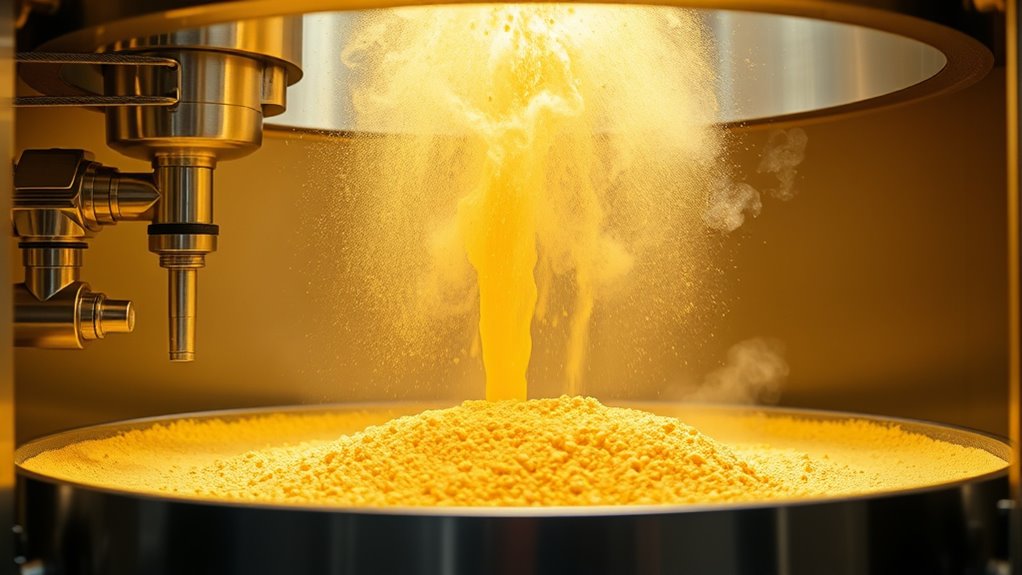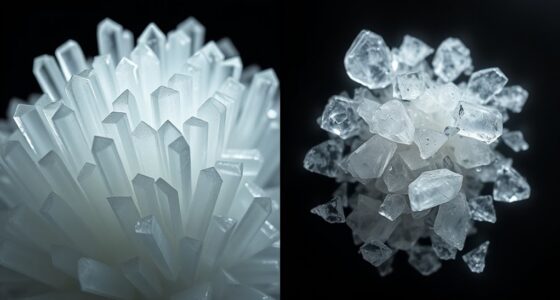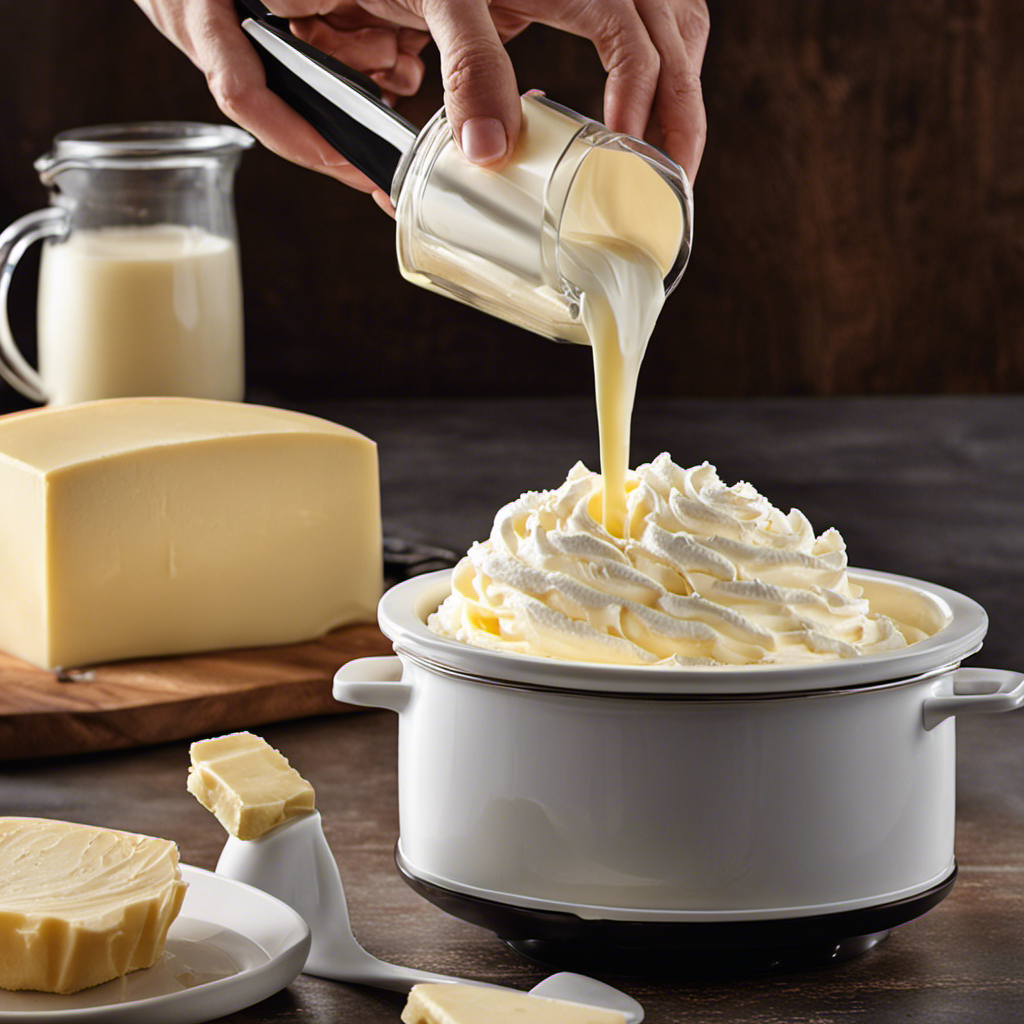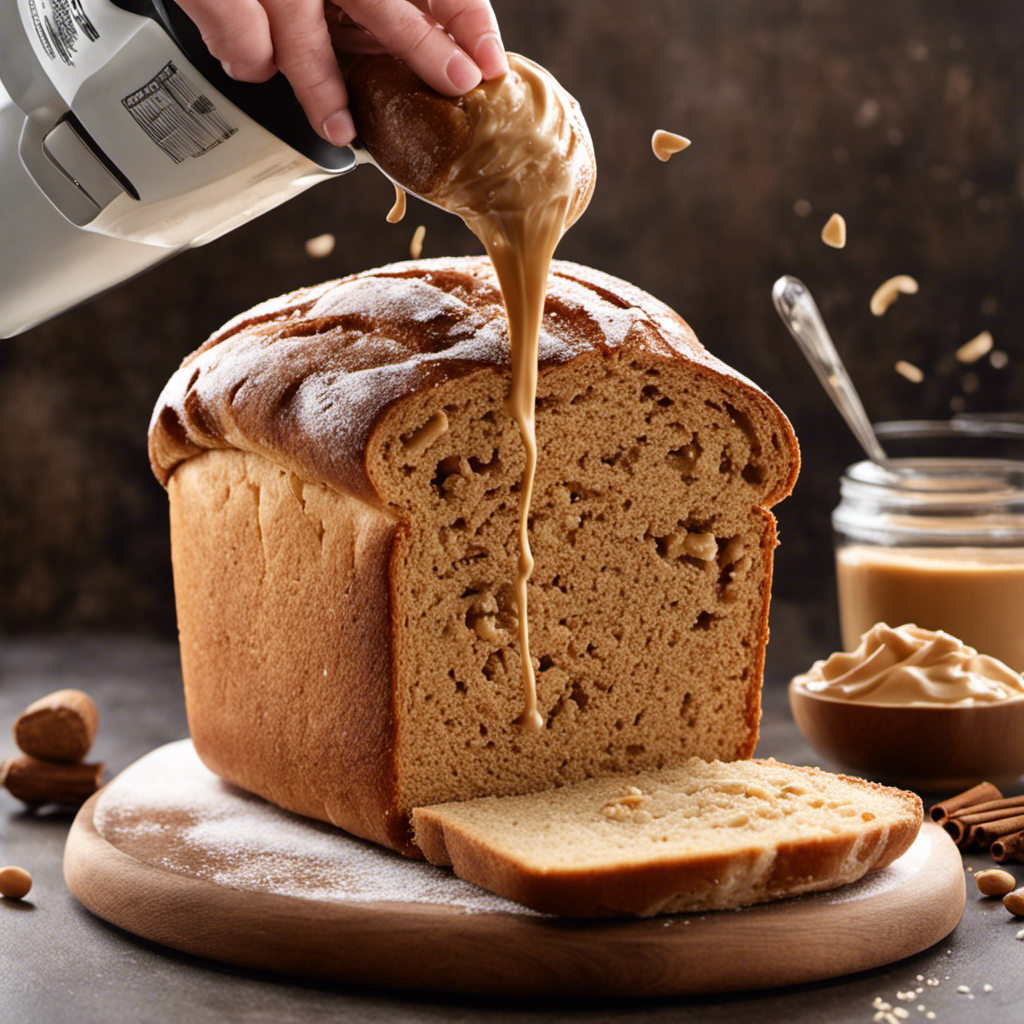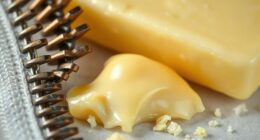Spray drying butter into powder involves emulsifying liquid butter to stabilize its fats and water content, then atomizing it into tiny droplets with a specialized nozzle. These droplets are quickly dried in a chamber with controlled temperature (around 150–180°C) and airflow, removing moisture rapidly. The resulting powder is collected and packaged carefully to preserve flavor and prevent clumping. If you’re enthusiastic to uncover more about each step, there’s plenty of detail to explore.
Key Takeaways
- Emulsify melted butter to create a stable, low-viscosity liquid suitable for atomization.
- Use high-pressure spray nozzles to produce fine droplets for efficient drying.
- Dry droplets in a controlled chamber at 150–180°C with low humidity for optimal moisture removal.
- Collect and package the powder carefully to prevent moisture absorption and maintain quality.
- The resulting butter powder retains flavor, aroma, and moisture retention properties for versatile culinary use.
Understanding the Basics of Spray Drying Technology
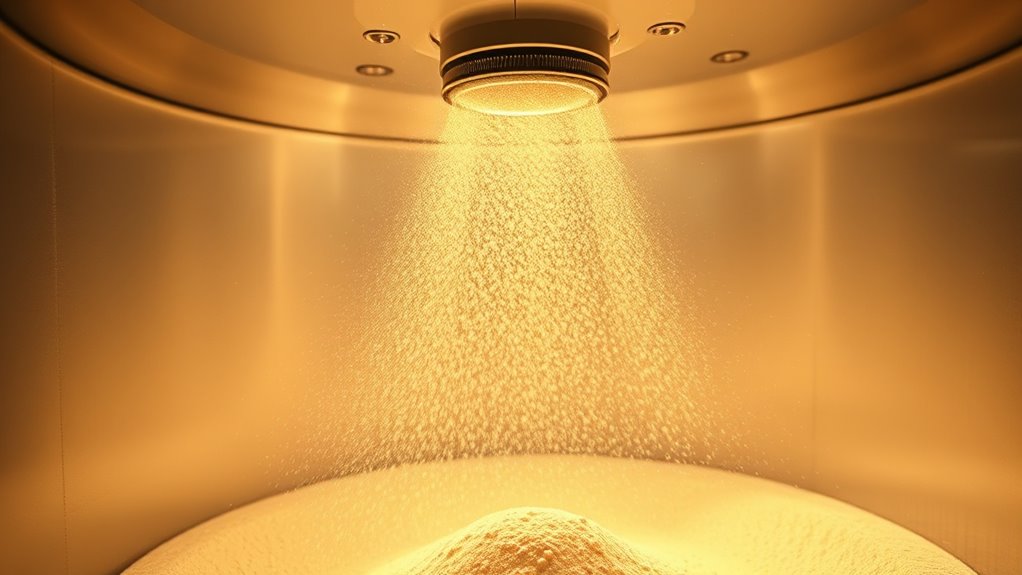
Spray drying technology transforms liquid substances into powder by rapidly removing moisture through a fine mist of droplets. When working with butter flavor, this process preserves its aroma and taste while converting it into a stable powder form. The key lies in the drying techniques used, which include atomization and controlled temperature settings. You’ll need to carefully select parameters to prevent heat damage and preserve flavor integrity. The spray dryer atomizes the liquid into tiny droplets, exposing them to hot air that instantly evaporates moisture. This method ensures a quick turnaround, resulting in a fine, free-flowing powder. Understanding these basics helps you optimize the process, ensuring that the butter flavor remains vibrant and the powder’s quality is maintained. Additionally, controlling the contrast ratio during drying can influence the visual appearance of the powder, ensuring consistent color and quality.
Preparation of Liquid Butter for Atomization
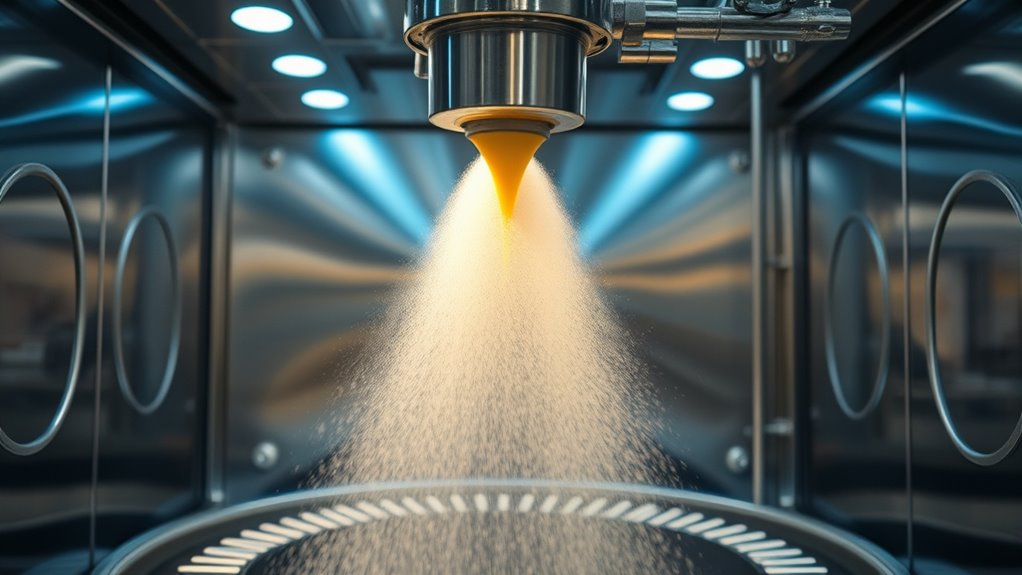
Preparing liquid butter for atomization requires careful attention to its composition and consistency. First, you need to focus on butter emulsification, ensuring the fat and water phases are properly combined to create a stable emulsion. Proper emulsification prevents separation during spraying and promotes uniform particle formation. Next, you must control the liquid butter viscosity; if it’s too thick, atomization becomes difficult, leading to uneven droplet sizes. Conversely, if it’s too thin, droplets may be too small or inconsistent. Adjustments can be made by adding small amounts of emulsifiers or diluents to achieve the ideal viscosity. Maintaining the right balance between emulsification and viscosity is essential for efficient spray drying, resulting in a high-quality butter powder with consistent properties. Optimal viscosity levels are crucial to ensure smooth atomization and uniform powder production.
Atomization and the Formation of Fine Droplets

How do you achieve the formation of uniform, fine droplets during atomization? It starts with selecting the right spray nozzle, which directly influences droplet size. A properly designed nozzle creates a consistent pressure and flow, breaking up the liquid butter into tiny, uniform droplets. The nozzle’s type and size determine whether you produce coarse or fine droplets, affecting overall spray quality. To get fine droplets, you need high atomization pressure and ideal flow rates, ensuring the liquid is sheared into small particles. Consistency in droplet size is essential for even drying and powder quality. By controlling these parameters, you can generate a stable spray of fine droplets, which is indispensable for efficient and uniform spray drying. Droplet size control is a critical factor in achieving high-quality powder production.
The Drying Chamber: Conditions and Parameters
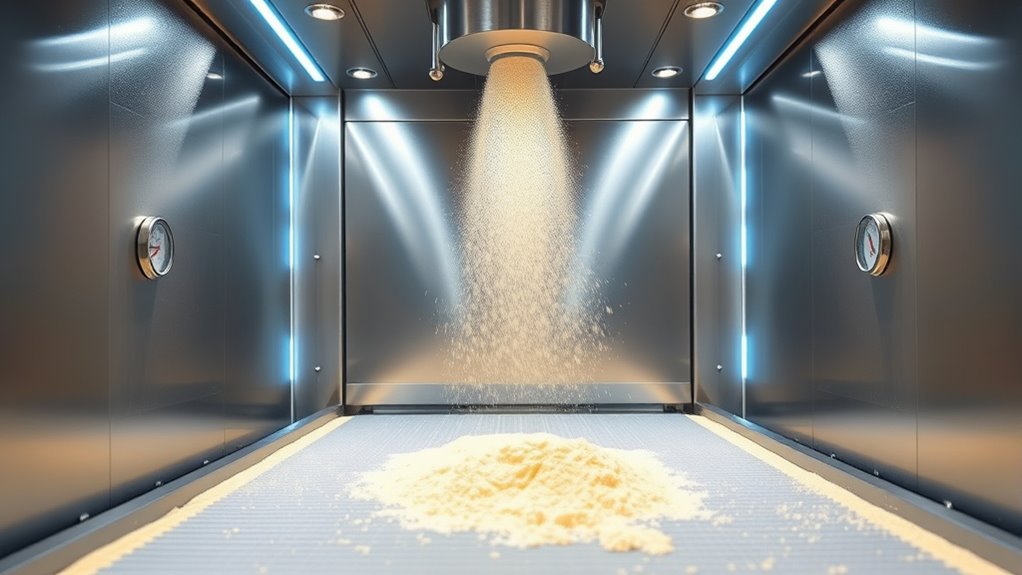
The conditions within the drying chamber play a crucial role in determining the efficiency and quality of spray-dried butter powder. Precise humidity control and temperature regulation are essential to prevent moisture retention or thermal degradation. Maintaining ideal temperature ensures rapid moisture removal without overheating the butter particles, preserving flavor and functionality. Humidity control prevents clumping and supports consistent drying. The following table summarizes key parameters:
| Parameter | Suitable Range | Impact |
|---|---|---|
| Temperature | 150–180°C | Affects drying speed and product quality |
| Humidity | 10–20% relative humidity | Ensures proper moisture removal |
| Airflow Rate | 300–500 m³/h | Promotes uniform drying |
| Residence Time | 1–3 seconds | Influences moisture content |
Adjusting these conditions guarantees a high-quality butter powder with ideal shelf life. Controlling environmental factors is vital for achieving optimal drying outcomes and ensuring product consistency.
Collection and Handling of the Butter Powder
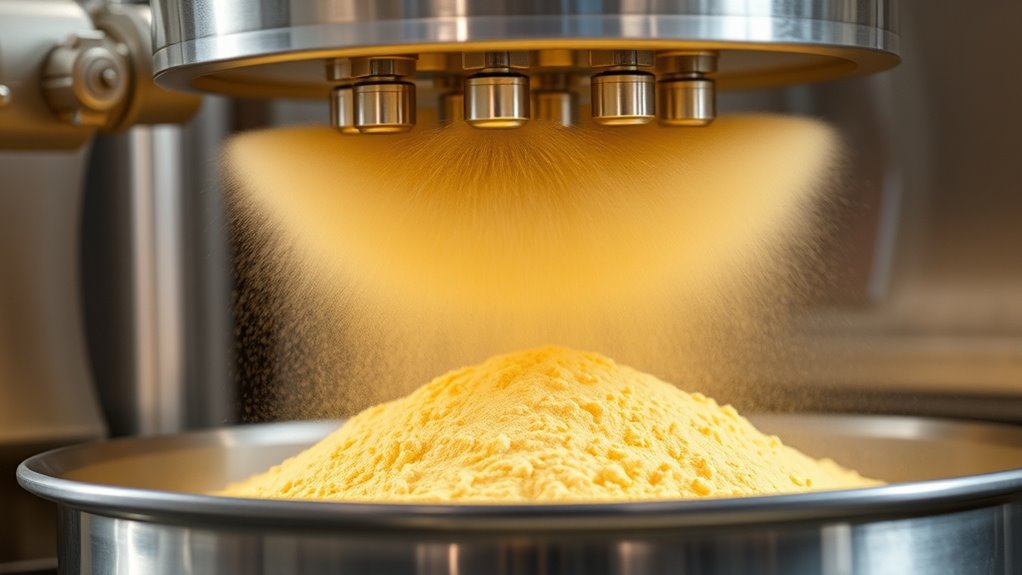
Once the spray drying process is complete, careful collection and handling of the butter powder are essential to preserve its quality. You should use appropriate packaging techniques to protect the powder from moisture, air, and light, which can degrade its properties. Ensuring a clean environment minimizes contamination risks during transfer and storage. Implementing proper airflow and dust control measures helps prevent cross-contamination and powder loss. Handling should be gentle to avoid clumping or breakage, maintaining uniform particle size. Regular inspection of packaging materials and storage areas guarantees hygiene and product integrity. Additionally, understanding the dog names can help in choosing a suitable name for the product or brand associated with it. By attentively managing collection and handling, you help keep the butter powder fresh, safe, and ready for its intended applications.
Advantages and Applications of Butter Powder in the Food Industry

Butter powder offers you a longer shelf life and easier storage compared to traditional butter. Its rich flavor enhances various dishes without extra liquid or melting issues. You’ll find it useful in many culinary applications, from baked goods to snack mixes. Additionally, essential oils can be incorporated into food products to provide natural flavoring and additional health benefits.
Extended Shelf Life
Have you ever considered how extending shelf life can benefit your food operations? Butter powder offers remarkable longevity, reducing spoilage and waste. This means you can stockpile supplies without constant refrigeration, boosting storage efficiency. Packaging innovations, like airtight seals and moisture barriers, further preserve quality over time. To illustrate, consider this:
| Benefit | Impact | Example |
|---|---|---|
| Longer shelf life | Less spoilage, waste reduction | Extended product availability |
| Storage efficiency | Space-saving storage | Compact packaging |
| Packaging innovations | Improved preservation | Airtight, moisture-proof bags |
Enhanced Flavor Profiles
Enhanced flavor profiles are one of the key advantages of using butter powder in the food industry. By spray drying, you can achieve superior flavor enhancement while preserving the rich aroma of fresh butter. The process locks in volatile compounds, ensuring that the distinctive buttery aroma remains intact during storage and transport. This aroma preservation allows food manufacturers to add authentic butter flavor to a variety of products without the risks associated with liquid butter, such as spoilage or spoilage-related flavor loss. As a result, butter powder provides consistent, intense flavor profiles that enhance dishes, baked goods, snacks, and seasoning blends. Its ability to maintain aroma and boost flavor makes it a valuable ingredient for creating high-quality, flavorful food products efficiently. Incorporating sound design techniques can also optimize the sensory experience of food packaging and advertising, further engaging consumers.
Versatile Culinary Uses
Thanks to its concentrated flavor and convenient form, butter powder offers remarkable versatility across a wide range of culinary applications. You can easily incorporate it into baked goods like cookies, cakes, and bread to enhance butter flavor without adding moisture. It’s perfect for seasoning snacks, instant mixes, and dry rubs, providing a rich, buttery taste that’s easy to distribute evenly. Butter powder also works well in sauces, soups, and dressings, giving recipes a smooth, authentic butteriness. Its portability and long shelf life make it ideal for food manufacturing, catering, and outdoor cooking. Additionally, moisture retention properties allow it to mimic fresh butter in various recipes, further expanding its culinary uses. With its versatility, butter powder simplifies ingredient management while maintaining the signature flavor you seek, making it a valuable addition to your kitchen or food production process.
Frequently Asked Questions
How Does Moisture Content Affect Butter Powder Shelf Life?
Moisture content considerably impacts your butter powder’s shelf life. Higher moisture levels compromise moisture stability, making the powder prone to clumping and microbial growth. To maximize shelf life, you need to guarantee proper storage conditions that keep moisture low, preventing spoilage. Maintaining ideal moisture content helps preserve flavor, quality, and safety, allowing your butter powder to remain stable and usable over an extended period.
What Are the Environmental Impacts of Spray Drying Butter?
You should consider that spray drying butter impacts the environment through energy consumption and emissions. Implementing sustainability practices, like optimizing energy use, can reduce greenhouse gases. This process may emit volatile organic compounds and other pollutants, but adopting emissions reduction strategies helps mitigate these effects. You can minimize environmental impacts by choosing eco-friendly energy sources and improving operational efficiency, ensuring a more sustainable approach to butter powder production.
Can Flavor Retention Be Optimized During Spray Drying?
You can optimize flavor retention during spray drying by controlling temperature and airflow, which helps preserve flavor compounds and enhances flavor preservation. Using protective additives can minimize flavor loss and prevent oxidation. Keep in mind, additive impact is vital; select additives that support flavor stability without affecting product quality. Adjusting process parameters thoughtfully ensures the butter powder retains its original flavor profile, making your product more appealing to consumers.
What Are the Energy Costs Involved in the Process?
Oh, sure, energy costs are just a drop in the bucket, right? In reality, spray drying butter into powder demands significant energy consumption, making cost analysis vital. You’ll spend on heating, atomization, and drying stages, which can add up quickly. While the process offers benefits, don’t overlook the substantial operational expenses. Carefully evaluate energy consumption to guarantee your project remains cost-effective and sustainable in the long run.
How Scalable Is Spray Drying for Large Industrial Production?
You can scale spray drying for large industrial production, but scaling challenges exist. As you increase equipment capacity, you’ll need larger or additional dryers, which can be costly and complex to operate. Maintaining product quality and consistent drying conditions becomes more difficult at higher volumes. Careful planning and investment are vital to guarantee your process remains efficient, reliable, and capable of meeting increased demand without compromising the final product’s quality.
Conclusion
By mastering spray drying, you can transform liquid butter into a convenient powder, opening new possibilities for your products. Imagine using butter powder to create shelf-stable baked goods with enhanced flavor release. For instance, a bakery that adopted spray-dried butter saw improved shelf life and consistent quality. Embracing this technology can streamline your production, reduce waste, and expand your creative options in the food industry.
